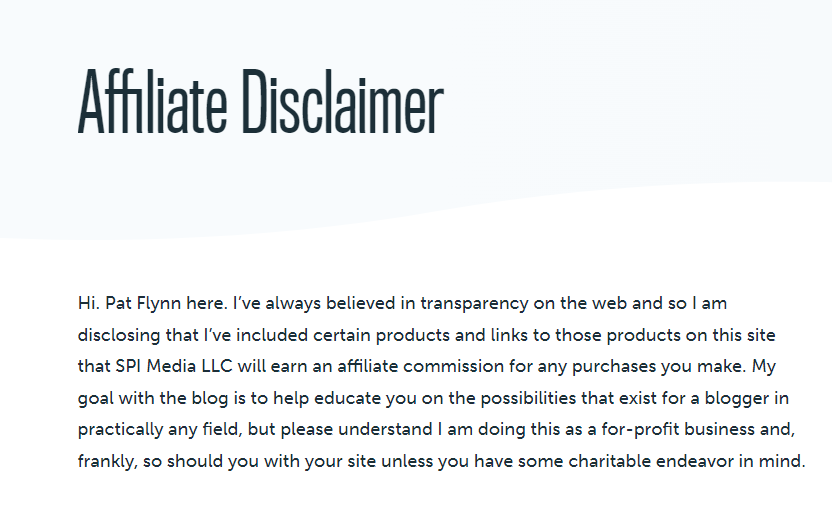Have you ever wondered who needs an affiliate disclosure and what exactly it includes? If so, go no further. This post will explain what affiliate disclosure is, who needs disclosure, and where you should add an affiliate disclosure for maximum compliance.
By the end of this post, you will have the answer to all of your questions.
But before we dig inside this post, let us first understand what an affiliate link disclosure is.
What Is Affiliate Link Disclosure?
Affiliate disclosure is an important element in any marketing, affiliate agreement, or other business transaction. It is a legal requirement for any website/blog that sells products or services.
Your readers need to know that you may receive a commission if they purchase a product through your link. The levels of disclosures differ depending on what the post is about: some recommendations could be just a simple “Hey, this stuff is great,” while others might include links to the vendor sites and full disclosures.
Using affiliate links helps you make money from your site, so you should disclose this fact to be ethical and honest.
Why Would I Need A Disclosure On My Site?
If you have any product reviews or recommendations on your website, you should be disclosing your affiliate relationships for those products.
The reason is that readers need to know when you might profit from a recommendation. As the FTC puts it:
Whether the consumer knows it or not, consumers have a right to know if reviewers provide their own opinions or paid sales pitches.
Affiliate marketing disclosure is like any other disclosure: It’s meant to inform people of your relationship with a business in order to help them decide whether to do business with you or not.
Because of this, the FTC has put together a comprehensive guide that covers what you need to include in an affiliate disclosure, where it needs to be located, and what needs to be said.
The FTC’s endorsement guide and affiliate disclosure rules aim to protect consumers, not punish website owners.
By failing to disclose your affiliate relationships, you’re risking not only legal action but also the trust of your readers and the success of your business.
Where Should The Affiliate Disclosure Go?
There’s no one-size-fits-all answer. The FTC requires that the disclosure be “clear and conspicuous.” That means it should be easy to find and read, regardless of whether the reader is accessing the web page from a desktop computer or a mobile device.
It should also stand out from the surrounding text so that people notice it without looking for it.
The general rule is that you must disclose affiliate links in content but not necessarily at the top of your post. A disclosure at the top of the page would be more noticeable but might distract readers from your content.
So, where should you put the disclosure? That’s up to you, but here are some guidelines:
The first option is to put it at the bottom of your blog posts if they’re long enough to require scrolling. That gives readers a chance to see your posts before being distracted by disclosures.
The second option is placing the affiliate link disclosure underneath each affiliate image or link. This way, the visitor sees the disclosure next to the affiliate link, making it more visible and easier to notice.
The last option involves creating a page dedicated to disclosing affiliate links and linking it to every page on your site that contains an affiliate link. This is probably the best option if you have more than one or two pages with affiliate links on them.
How To Write A Perfect Affiliate Disclosure For Your Blog
These are the main things that every affiliate disclosure should include:
- The first thing you want to do is explain the relationship between you and the brand. Keep it simple and direct: I am an affiliate/partner of [brand name].
- Next, describe what being an affiliate means for that brand. Again, keep it short and simple: This means that if you click on one of my links and make a purchase, I may earn a commission (at no additional cost to you).
- How your relationship with a brand affects the way, you write about it. (It’s a good idea to disclose this whether or not you’re being paid, since conflicts of interest can still arise).
The following text is an example of what you should note in the disclosure statement:
“Company X is a participant in the Amazon Services LLC Associates Program, an affiliate advertising program designed to provide a means for sites to earn advertising fees by advertising and linking to [amazon.com or whatever]”
Using this technique, your hyperlinked disclosure should be so clear that site visitors can’t possibly miss it.
Here are a few real-life blog examples to look at:
Cup Of Jo:

“Cup Of Jo” is one of the most popular lifestyle blogs online. This blog has placed its affiliate disclosure at the bottom footer, which is brilliant because they don’t have to add a disclosure to every post, and the wording is clear enough. It explains the three main factors every disclosure should include.
Smart Passive Income:

Another great example to look at is the Smart Passive Income blog affiliate disclaimer. The owner of this blog Pat Flynn dedicated a whole page to the disclaimer and placed the link at the bottom footer. So if anyone is interested in knowing how this blog does its business, can visit this page and learn more.
StartAMomBlog:

If you have been in the blogging industry for a while now, you are probably aware of the blog name “Startamomblog.” Suzi, the owner of this blog, has always been superb at explaining things on her blog, and you can tell this by her disclaimer. She strikes the main points by describing who she partnered with and the relation between her and the brand.
Join Others And Get A Free Keyword Research Course In Your Mail Box Right Away To Get More Traffic!
Conclusion
I hope you’ve found this information helpful. And if you’re a blogger, I hope that you’ll consider making a disclosure statement for your blog/site. It’s the responsible thing to do.
Basically, It is a legal requirement for any website that sells products or services. It allows readers to see you get paid for promoting the site. It doesn’t stop you from promoting it, and it doesn’t make you look untrustworthy, either.
Frequently Asked Questions
Q: What If You Link To Amazon And Just Say Check It Out?
Linking disclaimers such as, “I get a small commission from Amazon if you purchase something through this link,” or “Check out Amazon.com” are unlikely to provide sufficient disclosure of financial incentives for readers.
Disclosures should be easily noticeable by website visitors, close to the links they relate to, and written in unambiguous language that an ordinary consumer understands.
It doesn’t matter whether your disclosure is at the widget or bottom of the web page, but it must appear on all pages.
Q: Do You Have To Disclose Affiliate Links In Email?
The short answer is yes. You need to disclose that your email contains affiliate links. But why? Because it’s the law. And because you don’t want to get into trouble with your customers or email provider.
- 150+ Food Truck Business Names - March 9, 2025
- 130+ Day Care Business Names - March 5, 2025
- 15 Best Jobs For Moms To Work From Home - March 3, 2025

